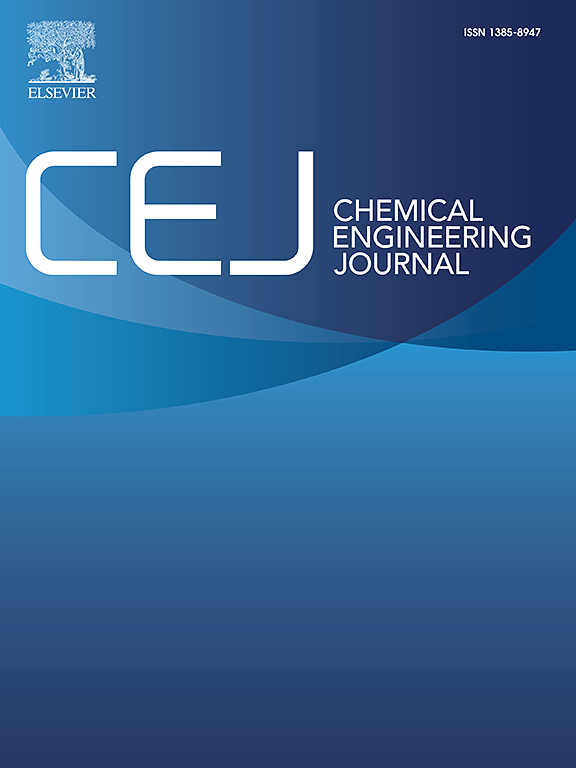Nanoconfinement in ordered mesopores materials for catalytic wastewater purification
IF 13.3
1区 工程技术
Q1 ENGINEERING, CHEMICAL
引用次数: 0
Abstract
Catalytic advanced oxidation processes (AOPs) have been challenged by low utilization efficiency of the reactive oxygen species, non-selective oxidation, hindered mass transfer, and reduced stability and activity of catalysts. Catalysis under nanoconfinement shows distinctive physicochemical properties and phase behavior that address the technical bottlenecks of AOPs; however, the confinement efficiency is highly dependent on substrate pore size. In this regard, ordered mesoporous materials (OMMs) and nanoreactors are specially promising to provide uniformly nanoconfined channels and microenvironment, effectively boosting catalytic oxidation performances during the wastewater purification. In this critical review, we first systematically elucidate the fundamentals of nanoconfinement in AOPs, focusing on its effects on chemical reactivity of reactants and intermediates, the stability and activity of catalysts, and the spatial nanoconfinement among different dimensional structures. Subsequently, the synthesis of OMMs with on-demand porous structure to facilitate nanoconfined reactions are reviewed. Afterwards, we discuss the applications of nanoconfined OMMs in catalytic wastewater purification from three aspects: redox agent-driven AOPs, electricity-driven AOPs, and light-driven AOPs. In conclusion, we summarize the fundamentals and application challenges of OMMs and their nanoconfined features in AOPs for wastewater purification, proposing strategies to drive advancements in this field.

用于催化废水净化的有序介孔材料中的纳米强化技术
催化高级氧化工艺(AOPs)一直面临着活性氧利用效率低、非选择性氧化、传质受阻以及催化剂稳定性和活性降低等挑战。纳米约束下的催化显示出独特的物理化学特性和相行为,解决了 AOPs 的技术瓶颈;然而,约束效率在很大程度上取决于基质孔径大小。在这方面,有序介孔材料(OMMs)和纳米反应器特别有望提供均匀的纳米封闭通道和微环境,从而有效提高废水净化过程中的催化氧化性能。在这篇综述中,我们首先系统地阐明了 AOPs 中纳米封闭的基本原理,重点介绍了其对反应物和中间产物的化学反应活性、催化剂的稳定性和活性以及不同尺寸结构之间的空间纳米封闭的影响。随后,我们对按需合成多孔结构的 OMMs 以促进纳米约束反应进行了综述。随后,我们从氧化还原剂驱动的 AOP、电驱动的 AOP 和光驱动的 AOP 三个方面讨论了纳米致密 OMM 在催化废水净化中的应用。最后,我们总结了 OMM 的基本原理和应用挑战,以及其在废水净化 AOP 中的纳米封闭特性,并提出了推动该领域进步的策略。
本文章由计算机程序翻译,如有差异,请以英文原文为准。
求助全文
约1分钟内获得全文
求助全文
来源期刊

Chemical Engineering Journal
工程技术-工程:化工
CiteScore
21.70
自引率
9.30%
发文量
6781
审稿时长
2.4 months
期刊介绍:
The Chemical Engineering Journal is an international research journal that invites contributions of original and novel fundamental research. It aims to provide an international platform for presenting original fundamental research, interpretative reviews, and discussions on new developments in chemical engineering. The journal welcomes papers that describe novel theory and its practical application, as well as those that demonstrate the transfer of techniques from other disciplines. It also welcomes reports on carefully conducted experimental work that is soundly interpreted. The main focus of the journal is on original and rigorous research results that have broad significance. The Catalysis section within the Chemical Engineering Journal focuses specifically on Experimental and Theoretical studies in the fields of heterogeneous catalysis, molecular catalysis, and biocatalysis. These studies have industrial impact on various sectors such as chemicals, energy, materials, foods, healthcare, and environmental protection.
 求助内容:
求助内容: 应助结果提醒方式:
应助结果提醒方式:


